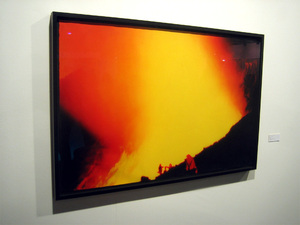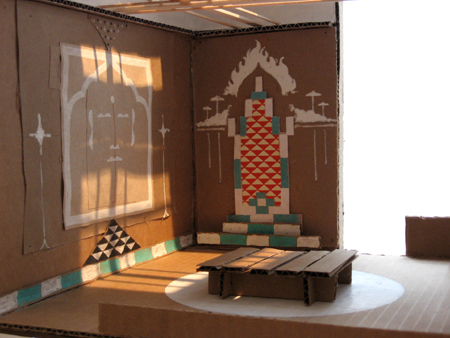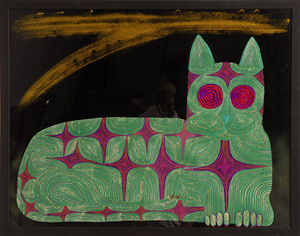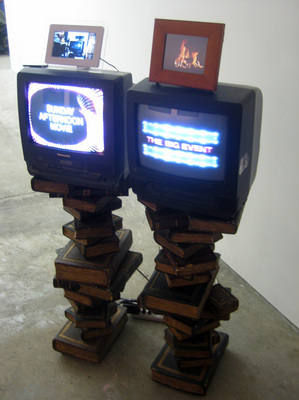This is an archive of the ArtCat Zine, 2007-2009. Please visit our new project, IDIOM.
Recently by Brent Burket
Ed: Brent's adventures in Miami continue; for an introduction, see Part 1.
After a quick and forgettable visit to the Bridge Art Fair I made my way over to Art Basel. This was my first time attending Basel and it was more than a little overwhelming. Oh, the massive massiveness! I spent 5 hours wandering around under a spell brought on by boatloads of great art, fluorescent lights and a deep fear of food poisoning/ (Seriously, I didn't think it was possible for the food to be worse than the NY fairs, but Art Basel wins this gastronomic race by a thousand miles.)
I was with my uncle and his wife and they were thrilled to see so many Miró's and other 20th Century artists in a smattering of the crazy-high-end galleries near the front of the fair. My favorite high-ender was Helly Nahmad, mostly because of their choice to go with an all-Dubuffet buffet. I am lucky enough to see Group of Four Trees every day of the week in New York, and it still isn't enough. To witness such a wide array of his paintings and smaller sculptures in one place was a very special thing.
Speaking of treats and thrills, one of my I'd-walk-across-hot-coals-to-see-their-work artists is Jack Goldstein, and the single enamel on paper painting at Mitchell-Innes & Nash was a new kick for me. It looked like a still from a Black Metal video for which somebody had accidentally used color stock. It makes Banks Violette seem like a little pussycat. But now, a question: is it possible for Joyce Pensato to put brush to linen or, in this case, charcoal and pastel to paper without me reacting with pure awe at the furious beauty of her work? Judging from this piece at Friedrich Petzel's booth, the answer would be, "No". I wish that Petzel had decided to focus soley on Pensato's work even though she has a show up now at his Chelsea gallery. Like Dubuffet, I just can't get quite enough.
Among the dozens of international art fairs dotting the map today, the quality of the art might vary, but one song remains the same at each: the sound of rich people who want you to overhear their declarations. In other words, when attending, there will certainly be entertainment included in the price of admission. The first art I came across in my recent trip down to Miami was outside SCOPE, an elegantly painful performance by artist Madeline Stillwell. About 15 seconds after I stopped to watch, a veteran X-Ray Woman beside me intoned, "I believe it's articulated. Is it articulated?" Huh? Curiosity and social courtesy led me to interrogate her: "Excuse me? Articulated?" She was ready. "Is it a robot?" Awesome. It was as if she was unable to conceive of a piece of art that wasn't an object, that couldn't be bought. Welcome to Miami, dude.
On entering SCOPE I was greeted by a towering, um, tower of fabric by artist Derick Melander. Just around the corner I found a friendly face in John Pollard of ada Gallery from Richmond who informed me that Melander was one of ada's artists. A second mighty ada find was a few works from a tire series by artist Shannon Wright, a sort of totem on a roll. Overall, the Miami version of the fair was much more consistent than its NYC incarnations. My favorite booth in the fair was easily Glowlab's which had been taken over by Spanish artist Roberto Mollá. This series of paintings and drawings deploys a strong formalism in the anime style.
Mollá's Japan connection reminded me: let's not forget the SCOPE-affiliated Art Asia Fair. Actually, let's.
"I love Mumbleboy!" That's not the kind of exclamation you would have heard from me before I met Hanna Fushihara Aron and her husband, the artist David Aron. Hanna's gallery, Little Cakes, cherishes the power held by all things gentle. In other words, everything I mistrust when it comes to art. And Mumbleboy? He's half of the duo known as Mumbreeze whose 2007 show at Little Cakes featured paper maché super heroes. This is not something I would have found immediately convincing had Hanna's curatorial tastes not already demonstrated the weight in whimsy so many times before.
i've nothing to lose
nothing to gain
i'll kiss you in the rain
--from Blackout, David Bowie
Jeremy Gilbert-Rolfe
Alexander Gray Gallery - 526 West 26th Street #1019, New York NY
April 30 - June 14, 2008
At the reception for Jeremy Gilbert-Rolfe's transcendent show at Alexander Gray one of the guests kept prattling on about somebody they knew who knew David Bowie. Y'know, the typical overhear-me-please stuff that one sometimes hears at openings. But it was OK, because their random noise sent me in an appropriate direction: West Berlin, 1976.
Let me explain. I was climbing into the painting, Up, and thinking about all the ways it explores and exploits The Grid when my jabbering pals put The Thin White Duke into my head. In '76, when Bowie needed to get off the grid of a certain approach to song (and career) he went to West Berlin with Brian Eno to record two great albums, Low and "Heroes". The time signatures and melodies are never exactly where they should be, but somehow Bowie's escape from the grid makes the listener even more aware of it, not unlike the the Krautrock from which Bowie and Eno stole so liberally.
But I deviate. Obviously.
Swirly Music
Brian Belott
CANADA - 55 Chrystie St, New York NY
29 November 2007 - 20 January 2008
"Go back to those gold sounds"
--Pavement
The 70s felt like the end of wanting, at least for a little while. Like a Carpenters' song, it was a lie, but it was nice while it lasted. Brian Belott's work touches on that gauzy itchy time. The era came burning through in the faded color of the found photographs I saw in a group show at Joymore in 2005. And now here it is again innocently (and sometimes not so innocently) consuming the space in his new show at CANADA, Swirly Music.
It should be said that I was more than a little worried when I saw the big, garish cats. Were they found paintings with some masterful glittery strokes applied by the artist? Across the room from the paitnings rest two Twin Tower like structures: dual, ostensibly random stacks of old hardcover books each support a television set on top, which in turn support a digital picture frame, the old media supporting the new(ish) and the new. These are the skeleton keys to Swirly Music. The two sets constantly play a stream of network IDs and TV movie intros that set the mood for the show, while the digital frames rotate through a series of Belott's found photographs — rhythmic and slow compared to the blown out colors and emphatic montage of the TV Land. The photos cover the spectrum from the odd rec room snapshot to a lost nudie of your neighbor's wife.
CANADA's big space is lined with colored clothespins and keys. The clothespins look like a continuous keyboard, while the keys made me think of Stevie Wonder's Songs in the Key of Life. That and the contents of a bowl at the door of a key party. The paintings in the room are exuberant homages to groovy posters and caricature. They initially looked like something done by an excited kid in a high school art class, and yet there is an emotional center that kept pulling me back in. The different pieces in the room worked their collective charms on me, and made me, well, a little swirly. That feeling was augmented by the soft soothing sounds coming from the bank of gold-painted speakers on the wall. It was light mood music that was as dedicated and focused as the show. Perfect.
I'm not sure why Belott keeps returning to the "gold sounds" of memory, but I'm always thrilled that he does. Art this specific in its mood is nothing short of a miracle. Don't be fooled by the fact that you can buy pieces of Swirly Music to take home. This show is one big landscape of memory. The paint, glass, fur, clothespins, keys, and TVs are just the colors and hues Belott busts out to show you what he's seeing from behind the canvas. And what he sees is beautiful, wistful, and a little goofy. A rec room long gone, all played out. Only the memories and the soft strains of a distant music remain. Ray Coniff and Henry Mancini would be proud.
Ensemble
The Institute of Contemporary Art, University of Pennsylvania
118 South 36th Street, Philadelphia, PA
7 September - 16 December 2007
Thwang, bonnngggg, thwap, clink-clink, and "Hello, Yoko."
These are just some of the sounds you'll hear and one of the things you might get to say at Ensemble, a show of sound art curated by Christian Marclay at the ICA in Philadelphia. Marclay's has let the sense of whimsy that informs much of his own work do the same for the exhibition, letting that spirit run deliciously rampant for this show of 27 artists.
But as usual it's not all fun and games with Marclay. The assault of so many pieces in one room provides a tension that soars and eases depending on the number of visitors in the room. More subtle works share the space with louder, one-trick-ponies (but what tricks!). Some pieces are interactive while some are on their own; yet, all roads lead to sound. The works that are interactive (about half of them) imply that the titular ensemble isn't complete without an audience.
The doorway to this sonic feast is Mineko Gimmer's gentle, but hefty, gauntlet, Bamboo Forest. In sharp contrast directly in front of the entryway is Jon Kessler's paranoid Sniper #10, in which surveillance technology is used to immediately recontextualize the image of the viewer to disorienting effect. Two other unsettling, albeit hilarious, works are Dennis Oppenheim's Attempt to Raise Hell and Yoshi Wada's The Alarming Trash Can, both of which were a blast to watch to observe as museum goers discovered the surprises they held. Less assaultive surprises await in Doug Aitken's many timbred K-N-O-C-K-O-U-T, and Katje Kölle's Staccato (americano). Evan Holloway's Victory Song is the simplest and most elegant of Rube Goldberg's with only one action involving a brass ball rolling on a rack with the sound focused through a phonograph horn. The spirit of Ensemble is best exemplified by Yoko Ono's Phone Piece, a phone on the wall that Ono calls occasionally to speak with whoever happens to pick up the receiver.
Carsten Nicolai at Pace Wildenstein
534 West 25th St., New York, NY
October 5, 2007 — November 3, 2007
Fuck drugs. Carsten Nicolai has been altering my brain on a cellular level with his sounds for over ten years now. I was well-chuffed when I heard about his exhibition of sound and visuals at Pace Wildenstein on 25th Street. I've read about his installations, but I haven't had the pleasure of experiencing them first hand. His sound work has always reminded me of the vibrant edges of a Jo Baer painting from the 60's or 70's, dealing out perceptual challenges both beautiful and expansive in their simplicity and directness.
ZINE
HOME
TIPS / COMMENTS
CATEGORIES
CONTRIBUTORS
- Greg Afinogenov
- B. Blagojevic
- Adda Birnir
- Susannah Edelbaum
- Julie Fishkin
- Paddy Johnson
- Jessica Loudis
- Christopher Reiger
- Andrew Robinson
- Peter J. Russo
- Blythe Sheldon
- S.C.Squibb
- Hrag Vartanian






